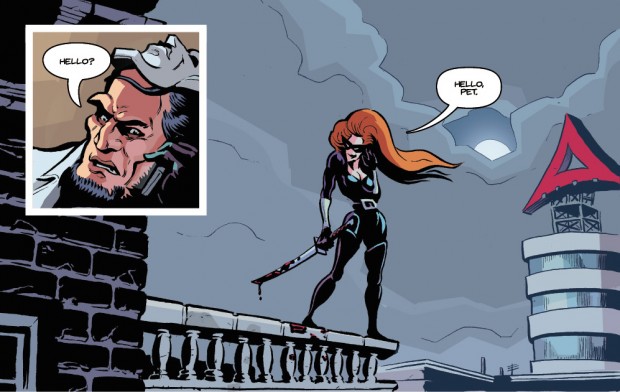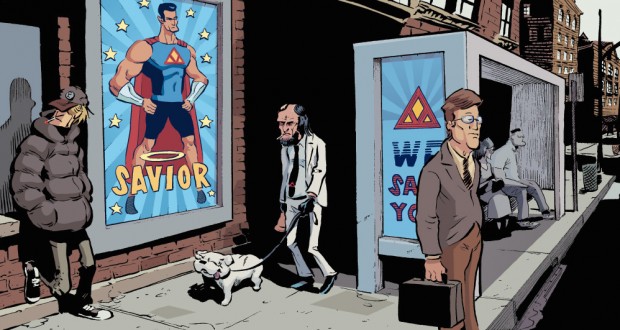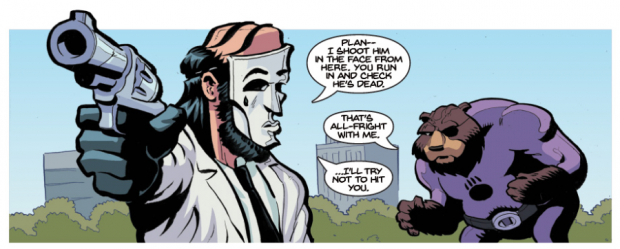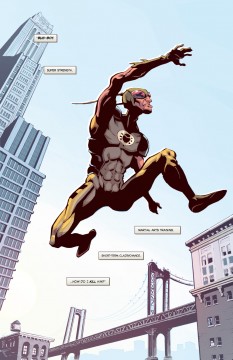“Humour is the equivalent of an action scene… but for talking heads” Ryan O’Sullivan and Plaid Klaus talk Turncoat
 “So how do I kill him?” is the question posed by superhero hitman Duke at the beginning of each chapter of superhero webcomic Turncoat. Unfortunately Duke is not quite as heroic as the people he is sent to assassinate (even Bug Boy!) yet he still manages to do the job, albeit badly! We catch up with Turncoat writer Ryan O’Sullivan and artist Plaid Klaus to find out why humour is so important in their comics and why lead character Duke doesn’t get all the best lines.
“So how do I kill him?” is the question posed by superhero hitman Duke at the beginning of each chapter of superhero webcomic Turncoat. Unfortunately Duke is not quite as heroic as the people he is sent to assassinate (even Bug Boy!) yet he still manages to do the job, albeit badly! We catch up with Turncoat writer Ryan O’Sullivan and artist Plaid Klaus to find out why humour is so important in their comics and why lead character Duke doesn’t get all the best lines.
Tell us about the inspiration for Turncoat, what made you decide to create a bumbling superhero assassin?
Ryan: Like most comic readers, I’m a big fan of superheroes. But as a comic creator the main problem is finding a new approach to these sorts of genre stories. The original concept I had for Turncoat was a story about a regular guy who hunted superheroes for a living, with the “hook” being the inventive/realistic ways in which he killed them. This was obviously the most generic and boring early-2000s style comic idea ever, so I quickly scrapped it; eventually deciding to mutate the idea into a midlife crisis comedy about a guy whose job just happens to be that he kills superheroes. If I can’t dazzle people with brilliant narrative, at least I can try and make them laugh. Key word: try.
Klaus: I have a love/hate relationship with Super Heroes. They brought me to the artistic medium of comic books, as is true with many other creators/readers, but the capes and tights have also kept the market in a strange nostalgic adolescent state. I get inspired by how, Grant Morrison, Super Gods, interprets the history of superheroes; but if I was to be honest, I feel like the industry is beating a dead horse after a half-century of muscle men and large breasted heroines. The industry is just too saturated with super hero comics…so I decided to add to the problem, by agreeing to draw a super hero comic.

Duke is a real loser of a character, whether that’s his problems with his ex-wife or the fact you’ve given him a comb over, how important for the character development was it for you to make him into an anti-hero (and I mean that as the opposite to a hero, not some cool villain!) and how did the character develop from the early idea stage?
Ryan: There’s a tradition in British sitcoms of the protagonist being somewhat villainous: Basil Fawlty, Edmund Blackadder, Del Boy, etc. The interesting this is that, because they’re humourous, the audience is slightly charmed by them, and doesn’t necessarily hate them even though they’re villains. This is pretty much what I was aiming for with Duke – a despicable character that was funny rather than empathetic. He’s essentially Pierrot the clown with his sadness replaced with rage.
Klaus: Um…Ryan, no one has any idea who those villains are, you silly Brit. (Don’t forget we’re a UK website – Ed!) He’s right though, Duke’s weaknesses make him endearing and relatable. Originally I drew body builder/Punisher type, the stereotypical bounty hunter. Ryan corrected me by explaining, “No, no, no — you don’t understand, he’s a loser.” Genius, love it.
You seem to be parodying several superheroes in Turncoat, but without being as explicit as some books, so which are your favourite characters to write and/or draw? And did you intentionally base them on existing characters or did you just go for certain tropes instead?
Ryan: Characters like Saviour and The Black Prince are more based on their Commedia Dell’Arte archetypes (Il Capitano and Brighella, respectively) than the superheroes they draw their aesthetic from. I didn’t set out to parody superheroes, as I was much more interested in telling a comedy that happened to take place in a superhero universe. The difference is slight, but an important one. In regards to superheroes; it would be somewhat disingenuous of me to parody something I’m not actually critical towards.
Of all the characters in the story, I’d say my favorites are Duke, The Black Prince, and Galadorin. They tend to waffle. Just like me.
Klaus: I set out to parody the idea of “costumes” as a brand for each character. The satire of the art goes beyond just attire; it’s also in how the characters play their role. Black Prince for instance, he sees himself as Royalty, so his posturing is always theatrically poised with a nose to the air; also his outfit is an exaggeration of Shakespearian elements fluffed into a super hero outfit (which fit surprisingly well together).
I enjoyed humorously bending all the archetypes through a cynically humorous filter. My favorite designs were The Black Prince and Concrete Pete. Concrete Pete is based on my middle school Gym teacher, he’s big in stature, but it’s been decades since the golden years. I go into more detail about the designing of characters on the website.

How important is humour to the book? It could be a serious bleak story, but instead it has a very dry sarcastic sense of humour to it, was that always important to you when creating the story?
Ryan: Humour is very important to Turncoat. I don’t think the story would work if played straight as it would be too dark and somber. In fact, humour is more about setting the tone than going for a few easy laughs. One thing Terry Pratchett said was: “No clowns were funny. That was the whole purpose of a clown. People laughed at clowns, but only out of nervousness. The point of clowns was that, after watching them, anything else that happened seemed enjoyable.” I think that’s important to remember in comedy; everything can’t be laugh out loud funny. Some parts should be, but the vast majority tends to just be light hearted filler to keep readers’ spirits high enough to appreciate the next joke.
This is pretty much what Duke’s purpose is, narratively. He’s not especially funny, if anything he’s the perpetual straight man, constantly setting up other characters to have the funny lines. In Fawlty Towers it was always Manuel who had the best lines. In Blackadder it was always Baldrick. In Turncoat it’s the bit-part characters like Scarebear or Galadorin.
Humour is also a very useful narrative tool. One thing I learned from John Cleese is that you can hide exposition with humour. If you’re keeping the reader’s mind occupied with something funny, then they are more likely to forgive you shamelessly explaining the story to them. You can also use humour to hide plot holes, but you have to be very subtle about it (make it too overt/meta and you risk being corny). Humour is basically the equivalent of an action scene… but for talking heads.
Klaus’s art style is very important to Turncoat’s humorous tone; an animated “cartoony” style, but heavy on the blacks to give it a semi-noir feel. Absolutely perfect for a dark comedy. His composition is also very funny; his arrangements of the various characters and environments to help the rhythm of the lines really hit home. I’m lucky to work with an artist who can make my moderately amusing scripts read much funnier than they actually are. Cheers mate.

Klaus: Thanks Ryan, your humor is what sold me on the project; it’s what makes this story fun to create. I’ve always been into both comics and newspaper cartoon strips, with Turncoat I got the best of both worlds as an artist. I was able to elevate the camera choices, panel framing and artwork to graphic novel status, but still got to play with characters in the manner of a cartoon. At the same time, I didn’t have to go to slap stick with the art, because the humor was subtle and threaded throughout the book. The delicacy in the humor allowed me to put the focus on the acting using cartoon caricatured expressions and proportions.
How did the pair of you come to be working together on this? Am I right in thinking Ryan you are in the UK and Plaid you are in the US? How did this affect your working relationship or is it not so much of an issue these days thanks to Skype and email?
Ryan: Me and Klaus met on a comic creative dating website online forum called Comic Experience. It’s run by a former Marvel and IDW editor called Andy Schmitt, and is a great place to find that special someone creative collaborators. I pitched the series to Klaus, and away we went. Despite being from two warring families living on opposite sides of the world we still managed to fall in love make it work.
Klaus: Ryan had me at, “hello.”
You’ve released the whole series as a webcomic with daily updates! How far in advance did you have to work to make this feasible? And does it help working so far ahead as it makes you nail down your ideas before you start publishing?
Ryan: We had the entire thing written before we began. And I think we were…three issues in before we started posting it online? It’s important to have a buffer in case of delays. I’m lucky though, Klaus has never actually delayed in delivering anything. He’s very professional.
Klaus: I don’t sleep. I perform a nightly ritual evoking the spirit of Kirby and Schultz to possess my body and draw until I lose consciousness.

What were the advantages to you of publishing as a webcomic first and did you have to tweak the pacing to make sure you had a mini cliffhanger at the end of every page? (Speaking of which, I love the fact you start each chapter with the same splash page and question about how Duke is going to kill his latest hero, was that inspired by the webcomic structure or the possibility of it appearing in print eventually?)
Ryan: As I mentioned above, the entire comic was written before we began. It wasn’t written with mini cliffhangers in mind as I think that sort of thing can be a little patronizing to readers. If the story connects with them they’ll keep reading; you don’t need to trick them narratively.
The opening splash pages with the narration boxes were inspired by something Joshua Fialkov did in “Echoes” (a graphic novel he released through Top Cow). He started each issue/chapter with the same three-panel structure to help readers fall back into the regular rhythm of his writing. I shamelessly stole the principles behind this idea and used them in Turncoat to get readers used to Duke’s mindset at the start of every chapter.
Klaus: Ryan’s splash pages were a great idea, really fun to draw! My favorite part of the web experience has been the reader comments and conspiracies about the unfolding of the story. It’s made Turncoat feel like an epic narrative!
Why go for the webcomic idea first rather than a collected print edition? And any plans for any other digital platform releases? (ComiXology for example?)
Ryan: We went the webcomic route first because we wanted people to actually read it. Turns out putting it online for free and advertising it bloody everywhere is good for that. It’ll be on Comixology eventually. But the Kickstarter will be the best place to get a digital copy at first.
Am I right in thinking your next step is to Kickstarter a collected edition? Will you be offering any cool extras? And will it be a graphic novel or a series of individual issues?
Ryan: We’re launching a Kickstarter on February 15th for a graphic novel of the entire six chapters of Turncoat. So if you want a physical copy of the comic this is your best bet. There will be extras: concept art, possibly a script (do people even like reading those?), some pinups; might even have extra stories if we hit our stretch goals. It’s going to have everything. It will be a beast of a book. And cheap. (Please buy it.)
Klaus: Yeah, I think drawing stuff for fans on a Kickstarter project is going to be a lot of fun, considering the humor involved in the project.
And finally, without giving away about the ending, what can we look forward to from you next and will you be returning to the world of Duke and co. any time soon?
Ryan: Duke’s story ends in chapter six. This doesn’t necessarily mean what you might think it does. If there’s enough demand for a follow-up book, and if the muse is knocking at my door with ideas, then sure I’d like to continue.
Klaus: I would definitely be on board to play with the Turncoat toys some more, it’s a great artistic sandbox.
You can read Turncoat via turncoatcomic.com


